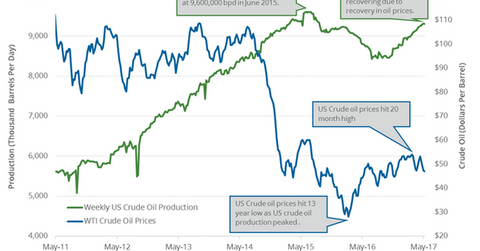US Crude Oil Production Fell for the First Time since February
US crude oil production fell by 9,000 bpd to 9,305,000 bpd on May 5–12, 2017. Production fell 0.1% week-over-week, but rose 5.8% year-over-year.
Nov. 20 2020, Updated 12:27 p.m. ET

US crude oil production 
The EIA (U.S. Energy Information Administration) reported that US crude oil production fell by 9,000 bpd (barrels per day) to 9,305,000 bpd on May 5–12, 2017. Production fell 0.1% week-over-week, but rose 5.8% year-over-year. US crude oil production fell for the first time since February 10, 2017. However, production is near the highest level since August 21, 2015. The rise in US crude oil production pressured crude oil prices. As a result, US crude oil (ERY) (ERX) (XES) prices are down 13.3% YTD (year-to-date).
Lower crude oil prices have a negative impact on oil and gas producers’ earnings like Comstock Resources (CRK), Northern Oil & Gas (NOG), Devon Energy (DVN), and Triangle Petroleum (TPLM). For more on crude oil prices, read Part 1 of this series.
Peaks and lows 
US crude oil production peaked at 9,600,000 bpd (barrels per day) in June 2015. On the other hand, it hit a low of 8,428,000 bpd for the week ending July 1, 2016—the lowest level since June 2014. Since then, US crude oil production has risen ~10.3%.
US crude oil production estimates  
The EIA estimates that US crude oil production will likely hit a 48-year high in 2018. US production could rise in 2017 and 2018 due to the following factors:
- rise in US drilling activity due to improvement in technology despite lower crude oil prices
- higher crude oil prices in 2017—compared to the previous year
- implementation of President Trump’s proposed energy policies
Tyche Capital Advisors thinks that if US production rose at the current pace, it would offset the reduction in supply from major oil producers’ production cut deal.
Read Could US Crude Oil Production Push Production Cut Deal Past 2017? for more on monthly US crude oil production.
In the next part of this series, we’ll take a look at US crude oil refinery demand and crude oil imports.
